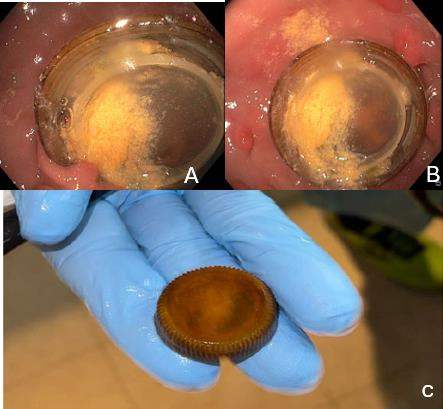Sunday Poster Session
Category: Stomach and Spleen
P2112 - A Cap-tivating Obstruction: Gastric Outlet Blockade by a Plastic Bottle Cap
Sunday, October 26, 2025
3:30 PM - 7:00 PM PDT
Location: Exhibit Hall

Alondra Velez-Santiago, MD (she/her/hers)
VA Caribbean Healthcare System
San Juan, PR
Presenting Author(s)
Alondra Velez-Santiago, MD1, Orlando Rodriguez-Amador, MD1, Julio D. Vega-Torres, MD, PhD2, Jose Martin-Ortiz, MD, FACG1
1VA Caribbean Healthcare System, San Juan, Puerto Rico; 2VA Caribbean Healthcare System, Sabana Grande, Puerto Rico
Introduction: Gastric outlet obstruction (GOO) is a clinical syndrome characterized by the mechanical impediment of gastric emptying, typically due to intrinsic or extrinsic obstruction at the pylorus or proximal duodenum level. The American Society for Gastrointestinal Endoscopy (ASGE) guidelines highlight that the most common benign cause of GOO is peptic ulcer disease, while the most common malignant causes are pancreatic and gastric cancers. We hereby present a unique case of GOO in an adult patient occurring after accidental ingestion of a small object.
Case Description/
Methods: Case of a 74-year-old male with a history of neurocognitive disorder, diabetes, and hypertension. Surgical history pertinent for urological procedures. There was a record of a previous hospitalization reporting new onset of bilious vomiting and imaging studies suggestive of gastric and bowel dilation. Patient responded with nasogastric tube decompression and correction of electrolytes. This time, the patient was brought to the ED with complaints of 2 episodes of coffee ground emesis. The patient denied nausea; the last meal was a turkey sandwich the previous day at 8 pm. Admitted with a diagnostic impression of suspected upper GI bleeding. Abdomen and pelvic CT with PO contrast reported moderate distention of the stomach with air fluid levels, and distal stomach/proximal duodenal mass could not be completely excluded. The patient was then referred to the Gastroenterology service to undergo EGD, and findings were consistent with GOO secondary to an impacted bottle cap in the pylorus (Figure 1). After successful removal, no further bleeding episodes were reported. The patient was able to tolerate the diet and was discharged.
Discussion: Gastric outlet obstruction due to foreign body ingestion is uncommon in adults, particularly when the object is radiolucent, such as a plastic bottle cap. In such cases, diagnosis may be delayed or missed on initial imaging. While CT can identify subtle abnormalities suggestive of obstruction, it may not always clearly delineate the nature of the obstructing lesion. This case highlights the critical role of endoscopic evaluation in diagnostic workup of GOO, particularly when imaging reveals inconclusive findings. In our patient, endoscopy was not only diagnostic but also therapeutic, permitting successful Roth net retrieval of the foreign body and avoiding the need for further unnecessary interventions. Timely endoscopic evaluation may reduce morbidity by enabling prompt diagnosis and intervention.

Figure: Endoscopy findings
Impacted bottle cap
Disclosures:
Alondra Velez-Santiago indicated no relevant financial relationships.
Orlando Rodriguez-Amador indicated no relevant financial relationships.
Julio Vega-Torres indicated no relevant financial relationships.
Jose Martin-Ortiz indicated no relevant financial relationships.
Alondra Velez-Santiago, MD1, Orlando Rodriguez-Amador, MD1, Julio D. Vega-Torres, MD, PhD2, Jose Martin-Ortiz, MD, FACG1. P2112 - A Cap-tivating Obstruction: Gastric Outlet Blockade by a Plastic Bottle Cap, ACG 2025 Annual Scientific Meeting Abstracts. Phoenix, AZ: American College of Gastroenterology.
1VA Caribbean Healthcare System, San Juan, Puerto Rico; 2VA Caribbean Healthcare System, Sabana Grande, Puerto Rico
Introduction: Gastric outlet obstruction (GOO) is a clinical syndrome characterized by the mechanical impediment of gastric emptying, typically due to intrinsic or extrinsic obstruction at the pylorus or proximal duodenum level. The American Society for Gastrointestinal Endoscopy (ASGE) guidelines highlight that the most common benign cause of GOO is peptic ulcer disease, while the most common malignant causes are pancreatic and gastric cancers. We hereby present a unique case of GOO in an adult patient occurring after accidental ingestion of a small object.
Case Description/
Methods: Case of a 74-year-old male with a history of neurocognitive disorder, diabetes, and hypertension. Surgical history pertinent for urological procedures. There was a record of a previous hospitalization reporting new onset of bilious vomiting and imaging studies suggestive of gastric and bowel dilation. Patient responded with nasogastric tube decompression and correction of electrolytes. This time, the patient was brought to the ED with complaints of 2 episodes of coffee ground emesis. The patient denied nausea; the last meal was a turkey sandwich the previous day at 8 pm. Admitted with a diagnostic impression of suspected upper GI bleeding. Abdomen and pelvic CT with PO contrast reported moderate distention of the stomach with air fluid levels, and distal stomach/proximal duodenal mass could not be completely excluded. The patient was then referred to the Gastroenterology service to undergo EGD, and findings were consistent with GOO secondary to an impacted bottle cap in the pylorus (Figure 1). After successful removal, no further bleeding episodes were reported. The patient was able to tolerate the diet and was discharged.
Discussion: Gastric outlet obstruction due to foreign body ingestion is uncommon in adults, particularly when the object is radiolucent, such as a plastic bottle cap. In such cases, diagnosis may be delayed or missed on initial imaging. While CT can identify subtle abnormalities suggestive of obstruction, it may not always clearly delineate the nature of the obstructing lesion. This case highlights the critical role of endoscopic evaluation in diagnostic workup of GOO, particularly when imaging reveals inconclusive findings. In our patient, endoscopy was not only diagnostic but also therapeutic, permitting successful Roth net retrieval of the foreign body and avoiding the need for further unnecessary interventions. Timely endoscopic evaluation may reduce morbidity by enabling prompt diagnosis and intervention.

Figure: Endoscopy findings
Impacted bottle cap
Disclosures:
Alondra Velez-Santiago indicated no relevant financial relationships.
Orlando Rodriguez-Amador indicated no relevant financial relationships.
Julio Vega-Torres indicated no relevant financial relationships.
Jose Martin-Ortiz indicated no relevant financial relationships.
Alondra Velez-Santiago, MD1, Orlando Rodriguez-Amador, MD1, Julio D. Vega-Torres, MD, PhD2, Jose Martin-Ortiz, MD, FACG1. P2112 - A Cap-tivating Obstruction: Gastric Outlet Blockade by a Plastic Bottle Cap, ACG 2025 Annual Scientific Meeting Abstracts. Phoenix, AZ: American College of Gastroenterology.

